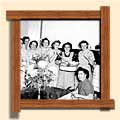 Heritage Community Foundation Presents
Heritage Community Foundation PresentsAlberta Online Encyclopedia
 |
|||
  |
|||
|
Home>> People and Communities>> Ethnocultural Communities>> Alberta's Italian Community>> Community Spirit |
|||
| Community Spirit | |||
These attitudes played themselves out not only in the mines but also in the mining camps and towns. The segregation was not always of an exclusionary nature. It may also have been self-imposed—it was easier to be with people that spoke one’s own language and shared values and beliefs. Thus, there was a well-established Little Italy in Bellevue. In the Drumheller Valley there were the all-Italian camps associated with the Sunshine and Brilliant Mines. In other communities there were clusters of Italian-owned homes in certain neighbourhoods.
The
struggle to establish themselves and the danger of the
occupation tended to bring the best out in people. This can be
seen time and again in the family histories in local history
books as well as oral histories.
But the passage of time brought acceptance and assimilation and this is seen through involvement in mainstream community activities. Italian immigrants began to be less strange and exotic and more like ordinary Canadians. They were business owners and professionals as well as officers in civic organizations. In fact, they seemed to be no different from anyone else. For example, in 1947, there were two Italian women members of the Order of the Royal Purple, Coleman Lodge No. 96. Del D’Appolonia was Associate Royal Lady and Muriel D’Amico was Inner Guard and Helen Fontana was Outer Guard. The Lodge undertook a range of good works in the community and fundraised to support these charitable activities. Canadians of Italian ancestry were community builders who believed in family, God and country. As jobs in the mines disappeared, many left for the cities but those who stayed did so because they loved the communities where they had laboured to establish themselves. Listen: To hear a miner's perspective on the isolation of mining camp life listen to Gus and Assunta Dotto's oral history excerpt. Listen: Angelo Toppano describes east Coleman, or "Bushtown," where he lived when he first arrived in 1913 (oral history excerpt). |
|||
 |
|||
For more on coal mining in Western Canada, visit Peel’s Prairie Provinces.



